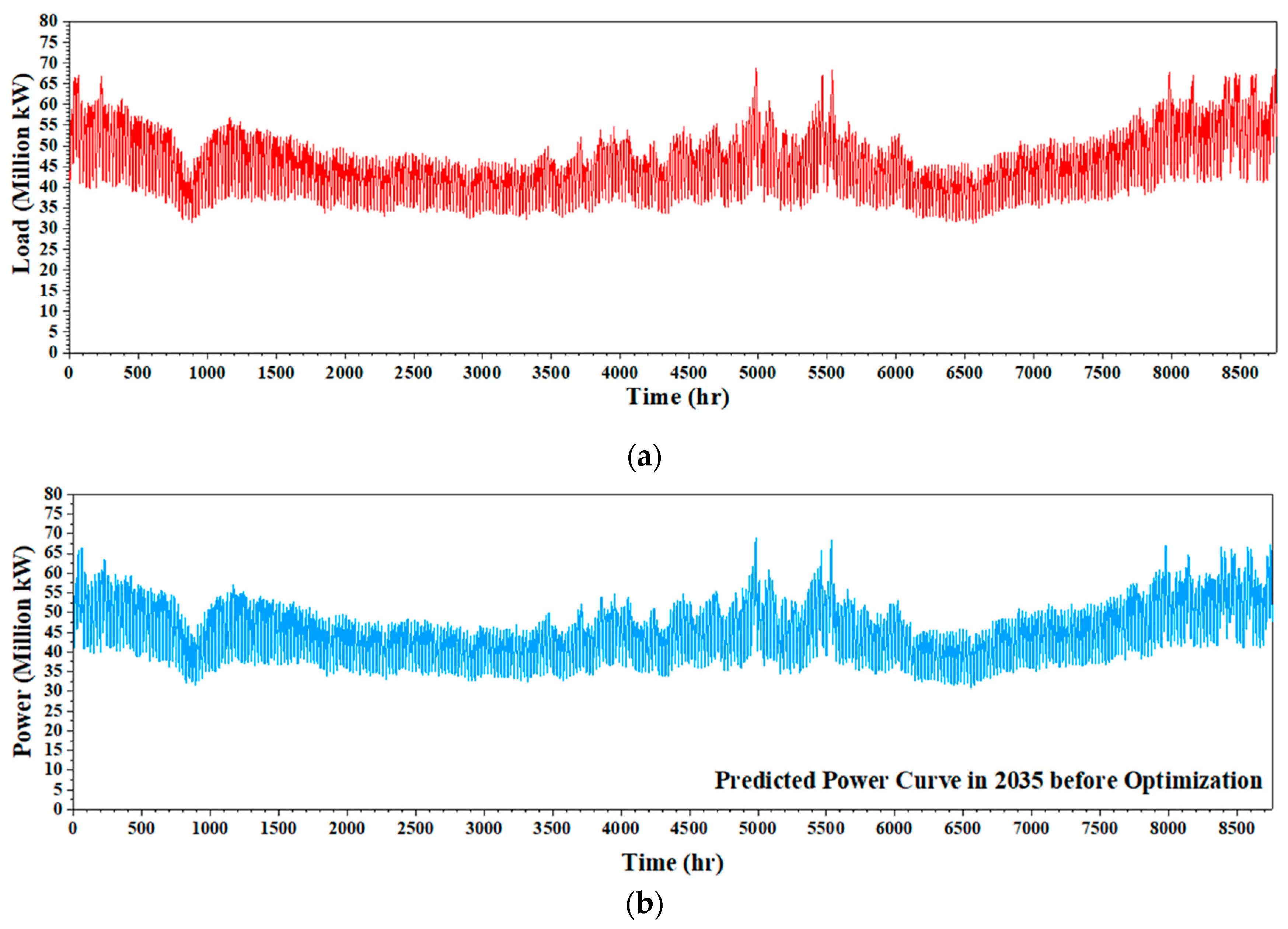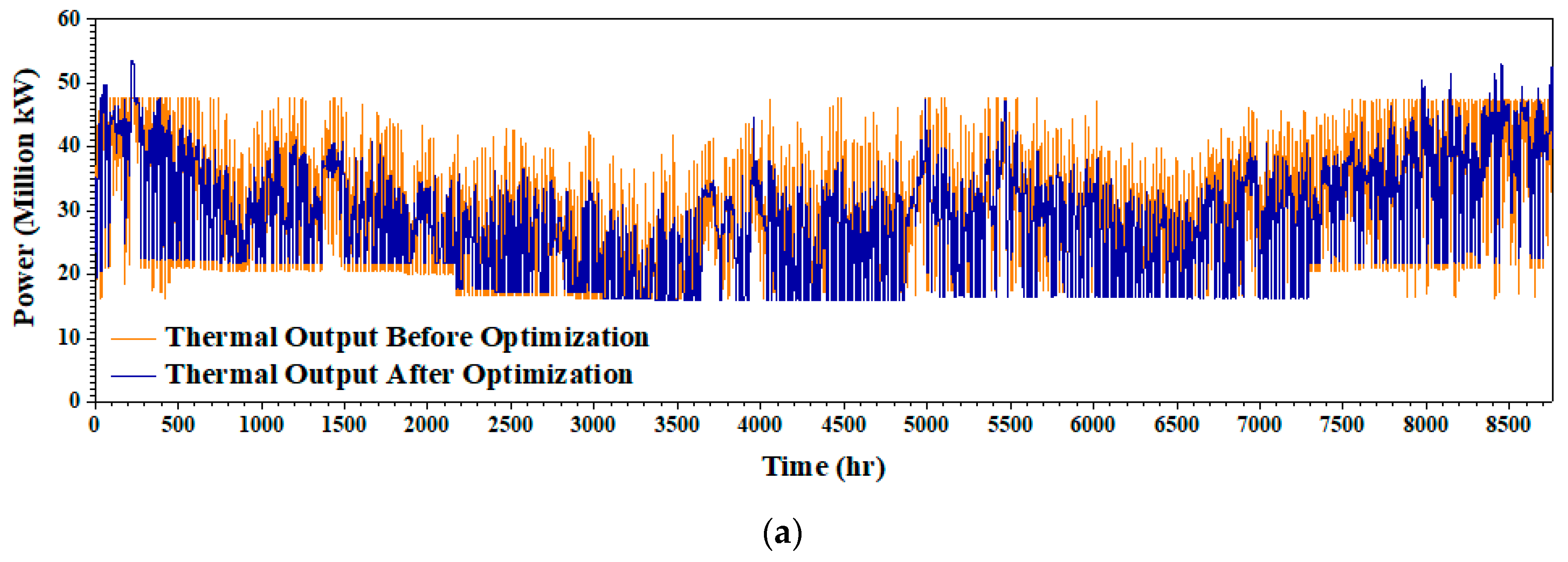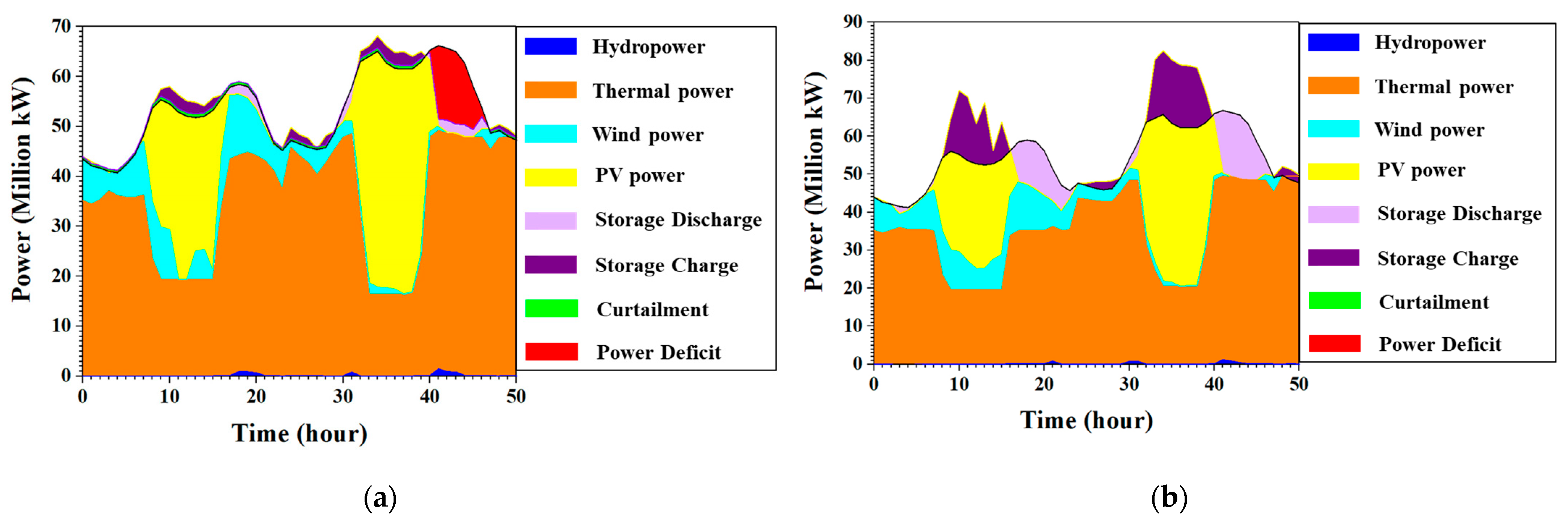Optimization of Provincial Power Source Structure Planning in Northwestern China Based on Time-Series Production Simulation
Abstract
:1. Introduction
2. Methods
2.1. Prediction of the Scale of Renewable Energy
2.2. Basic Model of the Time-Series Production Simulation System
2.2.1. Hydropower
2.2.2. Thermal Power
2.2.3. Renewable Energy
2.2.4. Energy Storage Systems
2.2.5. Load
2.3. System Optimization Objective
2.4. The Optimal Power Source Structure Model
- (1)
- Determine the scale of renewable energy for the studied year based on load and electricity levels, as well as the integration indicators for renewable energy sources.
- (2)
- Engage in annual 8760 h production simulation to identify maximum annual power deficit based on electricity demand, renewable energy scale, and the current installed capacity of traditional power sources and ESS. In this step, thermal power and energy storage system remain as the unknown variables.
- (3)
- Calculate the optimal scale for thermal power and ESS using the bivariate iterative method. The variables are continuously updated until predefined convergence criteria have been achieved. As shown in Figure 1, the outlined steps encapsulate a comprehensive strategy for achieving research objectives.
3. Case Analysis
3.1. Boundary Conditions
3.2. Optimization of Provincial Power Source
3.3. Evaluation and Discussion About the Optimization Results
4. Conclusions
Author Contributions
Funding
Data Availability Statement
Acknowledgments
Conflicts of Interest
References
- Hepburn, C.; Qi, Y.; Stern, N.; Ward, B.; Xie, C.; Zenghelis, D. Towards carbon neutrality and China’s 14th Five-Year Plan: Clean energy transition, sustainable urban development, and investment priorities. Environ. Sci. Ecotechnol. 2021, 8, 100130. [Google Scholar] [CrossRef] [PubMed]
- Sun, F.; Wang, Z.; Huang, J.; Diao, R.; Zhao, Y.; Lan, T. Application of reinforcement learning in planning and operation of new power system towards carbon peaking and neutrality. Prog. Energy 2023, 5, 012005. [Google Scholar] [CrossRef]
- Tang, M.; Wang, J.; Wang, X. Adaptable Source-Grid Planning for High Penetration of Renewable Energy Integrated System. Energies 2020, 13, 3304. [Google Scholar] [CrossRef]
- Xu, M.; Li, W.; Feng, Z.; Bai, W.; Jia, L.; Wei, Z. Economic Dispatch Model of High Proportional New Energy Grid-Connected Consumption Considering Source Load Uncertainty. Energies 2023, 16, 1696. [Google Scholar] [CrossRef]
- Hadi, M.B.; Moeini-Aghtaie, M.; Khoshjahan, M.; Dehghanian, P. A Comprehensive Review on Power System Flexibility: Concept, Services, and Products. IEEE Access 2022, 10, 99257–99267. [Google Scholar] [CrossRef]
- Wang, P.; Wang, C.; Hu, Y.; Varga, L.; Wang, W. Power Generation Expansion Optimization Model Considering Multi-Scenario Electricity Demand Constraints: A Case Study of Zhejiang Province, China. Energies 2018, 11, 1498. [Google Scholar] [CrossRef]
- Fang, H.; Shang, L.; Dong, X.; Tian, Y. High Proportion of Distributed PV Reliability Planning Method Based on Big Data. Energies 2023, 16, 7692. [Google Scholar] [CrossRef]
- Shi, Y.; Guo, R.; Tang, Y.; Lin, Y.; Yang, Z. Integrated Transmission Network Planning by Considering Wind Power’s Uncertainty and Disasters. Energies 2023, 16, 5336. [Google Scholar] [CrossRef]
- Juma, D.; Munda, J.; Kabiri, C. Power-System Flexibility: A Necessary Complement to Variable Renewable Energy Optimal Capacity Configuration. Energies 2023, 16, 7432. [Google Scholar] [CrossRef]
- Zhou, S.; Yang, J.; Yu, S. A Stochastic Multi-Objective Model for China’s Provincial Generation-Mix Planning: Considering Variable Renewable and Transmission Capacity. Energies 2022, 15, 2797. [Google Scholar] [CrossRef]
- Li, F.; Wang, D.; Liu, D.; Yang, S.; Sun, K.; Liu, Z.; Yu, H.; Qin, J. A Comprehensive Review on Energy Storage System Optimal Planning and Benefit Evaluation Methods in Smart Grids. Sustainability 2023, 15, 9584. [Google Scholar] [CrossRef]
- Suo, X.; Zhao, S.; Ma, Y.; Dong, L. Multi-type power generation planning method for power systems based on complex adaptive system theory. IET Renew. Power Gener. 2023, 17, 1899–1911. [Google Scholar] [CrossRef]
- Dong, C.; Li, M.; Fan, G.; Huang, Y.; Li, X. Research and Application of Renewable Energy Accommodation Capability Evaluation Based on Time Series Production Simulation. Electr. Power 2015, 48, 166–172. [Google Scholar]
- Dai, Q.; Zhang, J.; Wu, J.; Zhang, L.; Qin, X.; Zhang, Y.; Niu, Y. Differentiated Energy Storage Planning Method of Provincial Power Grids Based on Multi-partition Time Series Production Simulation. Electr. Power 2022, 55, 21–28. [Google Scholar]
- Zhao, S.; Suo, X.; Xu, Z.; Ma, Y.; Zhou, P.; Wang, X. Time series production simulation of multi-energy power system considering section constraints. Electr. Power Autom. Equip. 2021, 41, 1–6. [Google Scholar]
- Peng, X.; Li, H.; Zheng, G.; Sun, L. Research On Renewable Energy Accommodation Assessment Method based on Time Series Production Simulation. Acta Energiae Solaris Sin. 2020, 41, 26–30. [Google Scholar]
- Zhu, J.; Shi, K.; Li, Q.; Yu, R.; Xia, J.; Yuan, Y. Time Series Production Simulation and Renewable Energy Accommodation Capacity Evaluation Considering Transmission Network Power Flow Constraints. Power Syst. Technol. 2022, 46, 1947–1955. [Google Scholar]
- Lin, Z.; Yan, W.; Liu, H. A Simplified Time Series Production Simulation Method Considering Reservoir Operation and Inter-provincial Power Purchase. In Proceedings of the 2022 5th International Conference on Energy, Electrical and Power Engineering (CEEPE), Chongqing, China, 22–24 April 2022; pp. 795–800. [Google Scholar]
- Zhou, D.; Zhang, Q.; Dan, Y.; Guo, F.; Qi, J.; Teng, C.; Zhou, W.; Zhu, H. Research on Renewable-Energy Accommodation-Capability Evaluation Based on Time-Series Production Simulations. Energies 2022, 15, 6987. [Google Scholar] [CrossRef]
- Zang, T.; Wang, S.; Wang, Z.; Li, C.; Liu, Y.; Xiao, Y.; Zhou, B. Integrated Planning and Operation Dispatching of Source–Grid–Load–Storage in a New Power System: A Coupled Socio–Cyber–Physical Perspective. Energies 2024, 17, 3013. [Google Scholar] [CrossRef]







| Power Source Type | Installed Capacity |
|---|---|
| Thermal power | 47.71 (variable, initial value) |
| Hydropower | 3.60 |
| Wind power | 20.20 |
| Photovoltaic | 81.15 |
| ESS | 2.79 (variable, initial value) |
| Total | 155.45 |
| Item | Value (“+”as Surplus, “−” as Deficit) |
|---|---|
| Load | 66.61 |
| Transmission channel (export as −, import as +) | −0.59 |
| Power output | 50.02 |
| Thermal power | 47.71 |
| Hydropower | 0.88 |
| Wind power | 0.75 |
| Photovoltaic | 0.00 |
| ESS | 0.68 |
| Power surplus/deficit (surplus as +) | −17.18 |
| Power Source Type | Installed Capacity |
|---|---|
| Thermal power | 53.71 (variable, optimized) |
| Hydropower | 3.60 |
| Wind power | 20.20 |
| Photovoltaic | 81.15 |
| ESS | 16.79 (variable, optimized) |
| Total | 175.45 |
| Power Source Type | Electricity Generation | |
|---|---|---|
| Initial | Optimized | |
| Thermal power | 262,061 | 249,751 |
| Hydropower | 8902 | 9723 |
| Wind power | 38,311 | 39,233 |
| Photovoltaic | 87,058 | 106,187 |
| ESS | −1071 | −7881 |
| Total | 395,262 | 397,013 |
Disclaimer/Publisher’s Note: The statements, opinions and data contained in all publications are solely those of the individual author(s) and contributor(s) and not of MDPI and/or the editor(s). MDPI and/or the editor(s) disclaim responsibility for any injury to people or property resulting from any ideas, methods, instructions or products referred to in the content. |
© 2024 by the authors. Licensee MDPI, Basel, Switzerland. This article is an open access article distributed under the terms and conditions of the Creative Commons Attribution (CC BY) license (https://creativecommons.org/licenses/by/4.0/).
Share and Cite
Su, Z.; Yang, G.; Yao, L.; Zhou, Q.; Zhang, Y. Optimization of Provincial Power Source Structure Planning in Northwestern China Based on Time-Series Production Simulation. Energies 2024, 17, 4766. https://doi.org/10.3390/en17194766
Su Z, Yang G, Yao L, Zhou Q, Zhang Y. Optimization of Provincial Power Source Structure Planning in Northwestern China Based on Time-Series Production Simulation. Energies. 2024; 17(19):4766. https://doi.org/10.3390/en17194766
Chicago/Turabian StyleSu, Zhou, Guoqing Yang, Lixiao Yao, Qingqing Zhou, and Yuhan Zhang. 2024. "Optimization of Provincial Power Source Structure Planning in Northwestern China Based on Time-Series Production Simulation" Energies 17, no. 19: 4766. https://doi.org/10.3390/en17194766





